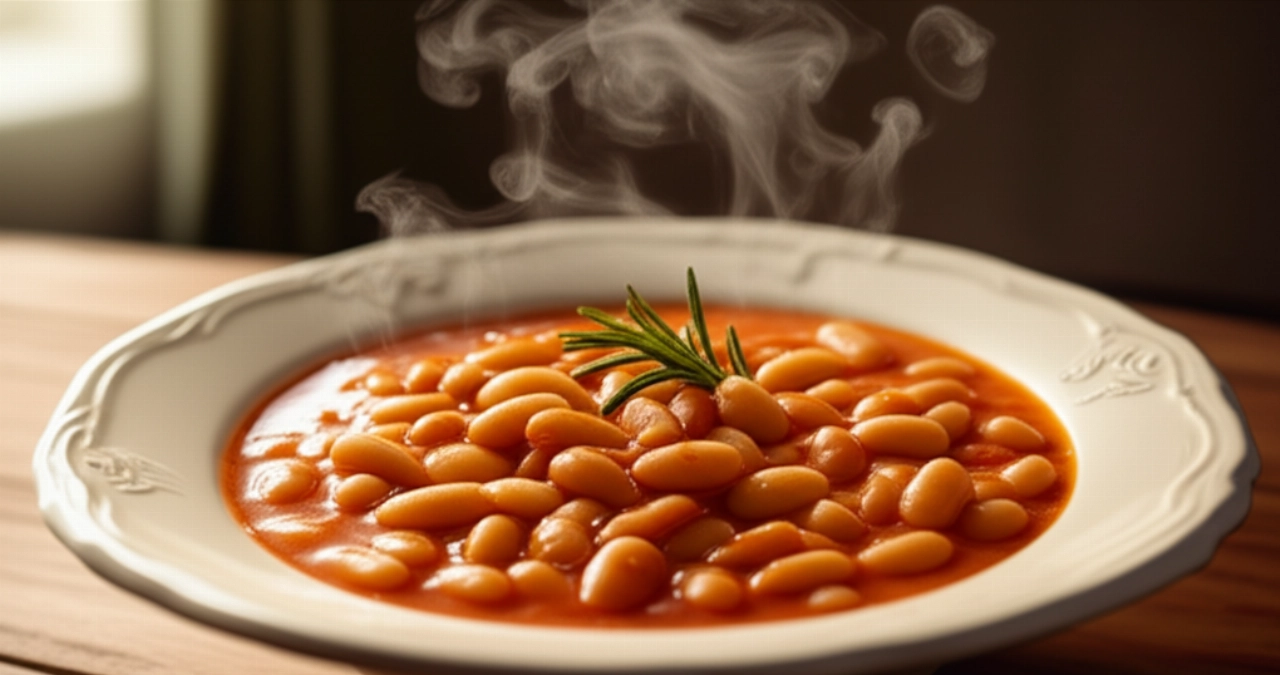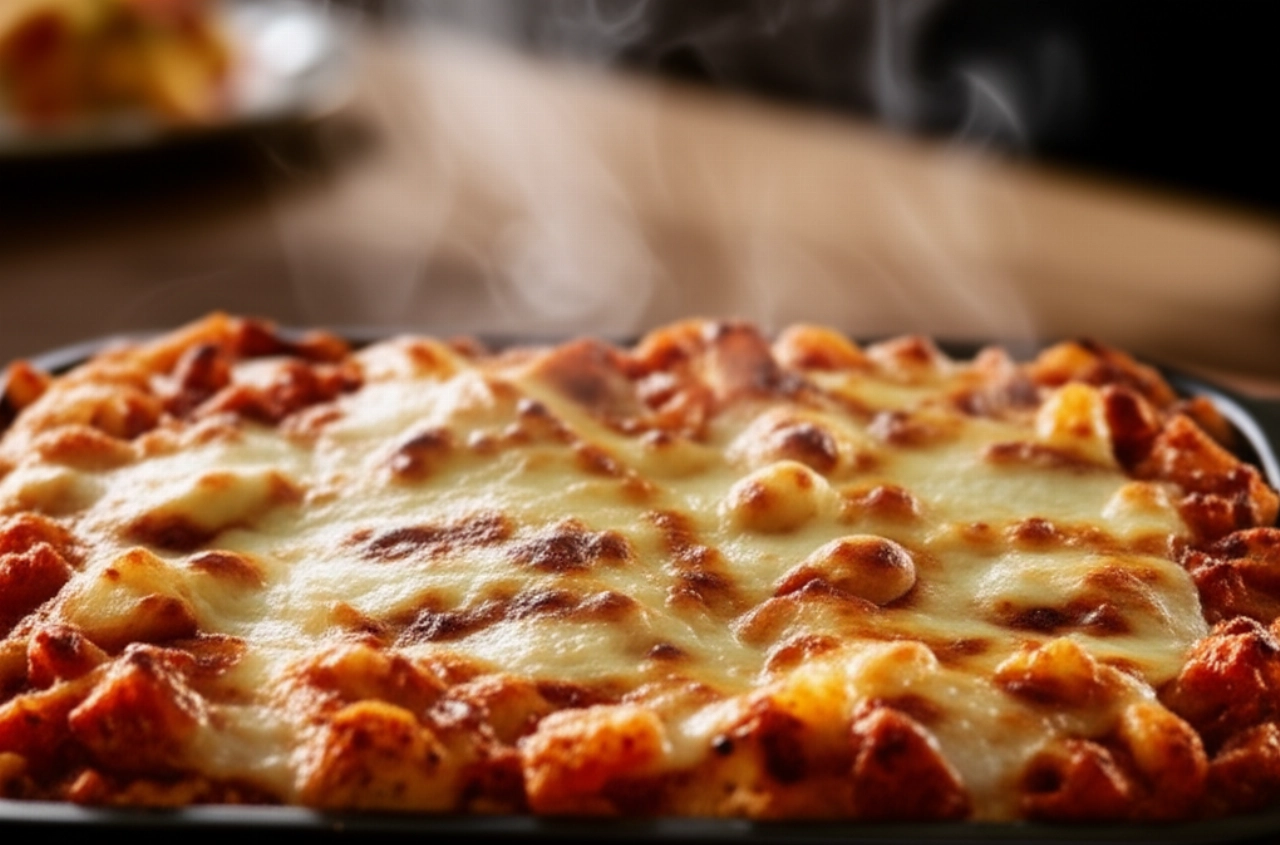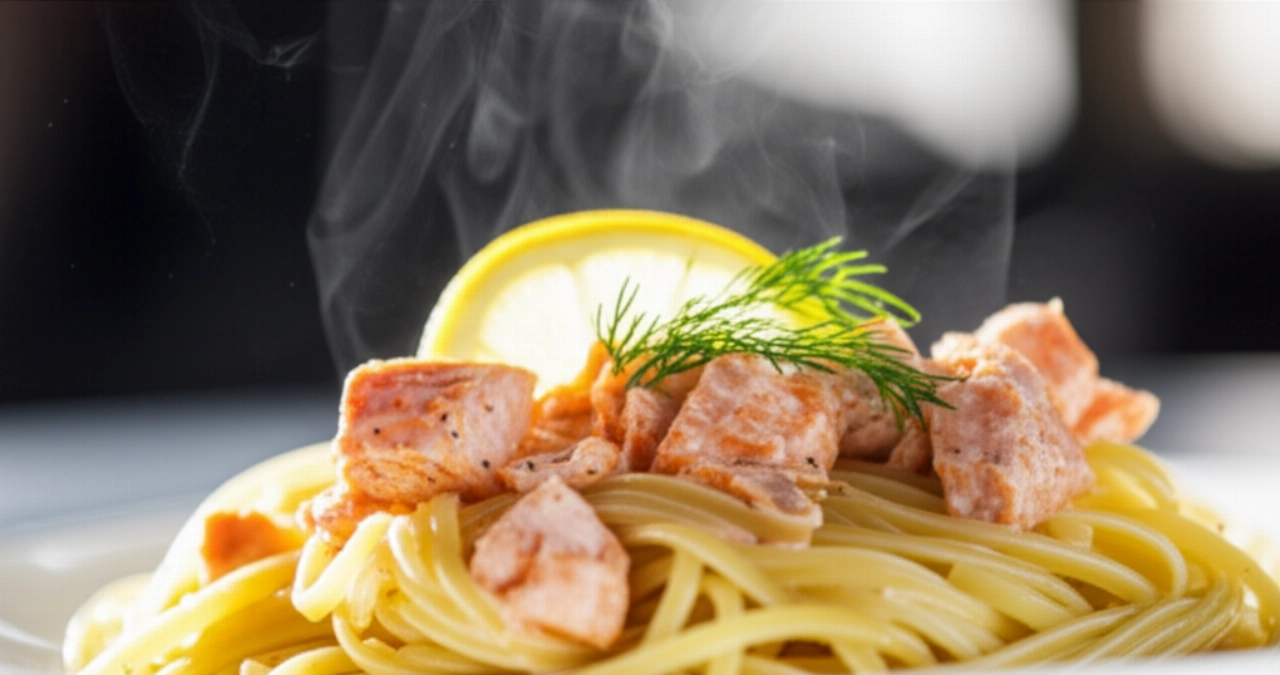There's a scent that smells of home, of a warm embrace, of childhood memories surfacing with every spoonful. Pasta e Fagioli is much more than just a dish: it's a comfort food that warms the heart and soul, a pillar of our culinary tradition.
But how many times have you tried to make it and it turned out too watery, bland, or with mushy beans? That feeling of frustration when the result doesn't meet expectations, or the fear of wasting precious time and ingredients, is something I know well. Finding the true recipe, the one that makes you say 'it's just like grandma used to make it,' seems like a challenge.
Make yourself comfortable, because here you won't just find a list of ingredients. This is the definitive guide, full of tricks and tips, to prepare a Pasta e Fagioli so thick, creamy, and flavorful that it will become your signature dish. I promise guaranteed success, without waste and with certainty of the result. Your table will be filled with smiles and that 'Wow!' that repays every effort.

Smart Ingredients for a Dreamy Pasta e Fagioli: The Choice That Makes the Difference
Every great dish begins with carefully chosen ingredients. It's not just about quantity, but about the quality and the reason behind each choice. Here's what you need for your applause-worthy Pasta e Fagioli:
- Dried Borlotti Beans (or Fresh): They are the undisputed protagonists. Dried borlotti beans, if properly soaked (at least 12 hours, changing the water a couple of times) and cooked slowly, release a deep flavor and a starchy texture perfect for creaminess. If you're in a hurry, you can use canned ones, but rinse them very well under running water to remove the preserving liquid and don't expect the same intensity of flavor.
- Mixed Short Pasta or Ditalini Rigati: Short pasta is ideal because it blends perfectly with the beans and sauce. Ditalini rigati, in particular, 'capture' the condiment. Choose a good quality pasta that holds its shape well during cooking and releases the right amount of starch to bind everything together.
- Lardo or Pancetta Tesa (unsmoked): A small piece, finely chopped, is the secret to a 'singing' soffritto. Its fat slowly melts, giving a unique depth of flavor, a true savory 'base'. If you prefer a lighter version, you can omit it, but know that you'll lose some of that authentic character.
- Classic Soffritto (Carrot, Celery, Onion): The base of every great Italian soup. Cut them into brunoise (very small cubes) so that they almost completely dissolve during cooking, releasing all their aromas without leaving coarse pieces.
- Quality Tomato Passata: Not too much, just enough to give color and a note of acidity that balances the flavors. Choose a thick and sweet-tasting passata.
- Vegetable Broth or Bean Cooking Water: The liquid you use is fundamental. If you cooked dried beans, their water is very rich in flavor and starch, use it! Otherwise, a good homemade vegetable broth (or quality bouillon cube) is ideal. Avoid plain water, unless strictly necessary, to avoid diluting the flavor.
- Extra Virgin Olive Oil: A drizzle at the end, to enhance all the flavors. Choose an oil with a medium fruitiness, not too aggressive.
- Garlic and Fresh Rosemary: An aromatic touch that makes all the difference. Whole or crushed garlic and a sprig of rosemary will release their aromas and can be removed at the end of cooking.
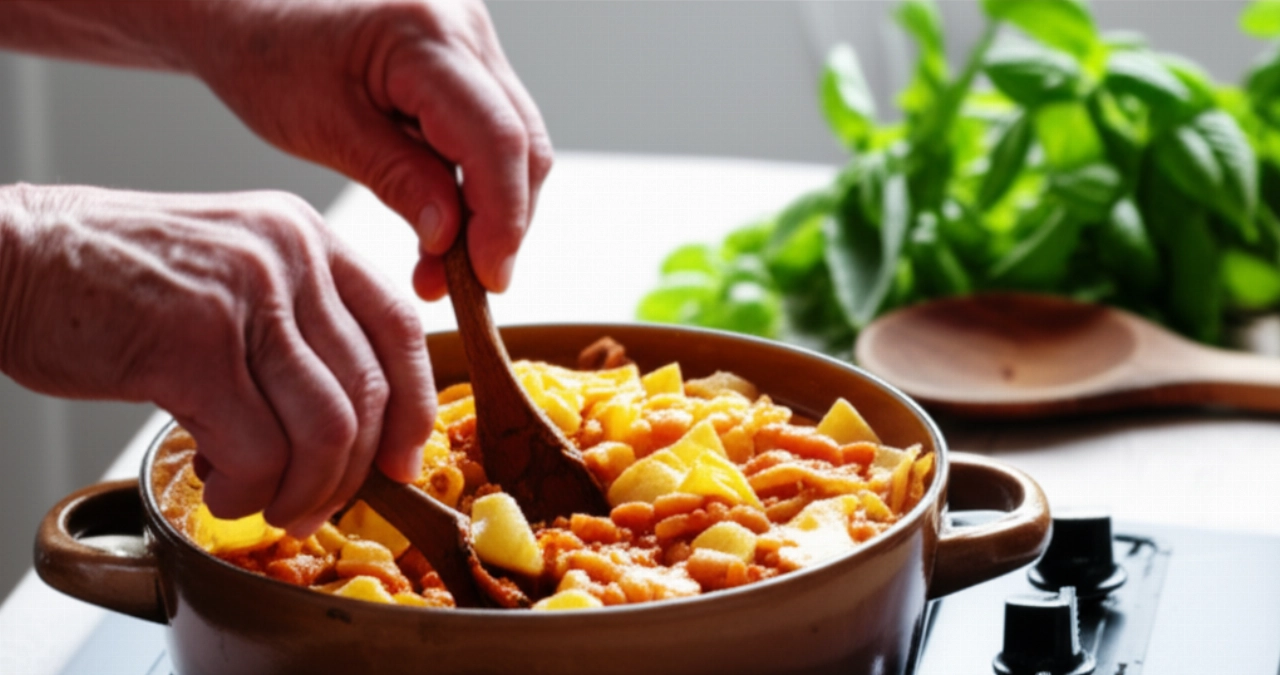
The 3 Mistakes That Make Pasta e Fagioli Watery or Bland (and How to Avoid Them)
Pasta e Fagioli is a simple dish, but it hides pitfalls. Here are the critical points that often lead to a disappointing result and how to overcome them, thanks to the secrets my grandmother passed down to me:
- Neglecting the Soffritto: Many underestimate this step. A hastily made soffritto, with poorly cut vegetables or cooked over too high heat, will not release all its aromas. The result? A bland base.
The trick: Cut carrots, celery, and onion into very small cubes (brunoise). Sauté them gently in a drizzle of oil (and the chopped lardo/pancetta) over very low heat, until they are almost transparent and very soft. This will take at least 10-15 minutes. This is the foundation of the flavor. - Not Managing Bean Consistency: If the beans are all whole, the soup will be too watery. If they break down too much, it will become a puree.
The trick: Once the beans are cooked, take about a third and coarsely mash them with a fork or pass them through a food mill (not with an immersion blender, which would make everything too sticky and homogeneous). This 'creamy' mashed bean mixture is the secret to giving the dish natural density and creaminess, without the need for thickeners. - Adding Too Much Liquid Too Soon: Pasta e Fagioli should be thick and enveloping, not a soup. Adding too much broth or water at the beginning will make it difficult to achieve the right consistency.
The trick: Add the broth (or bean cooking water) little by little, as the pasta absorbs it. Remember that the starch released by the pasta during cooking will also help to thicken everything. Adjust the amount of liquid at the end of cooking to achieve the desired density, keeping in mind that it will thicken further as it rests.
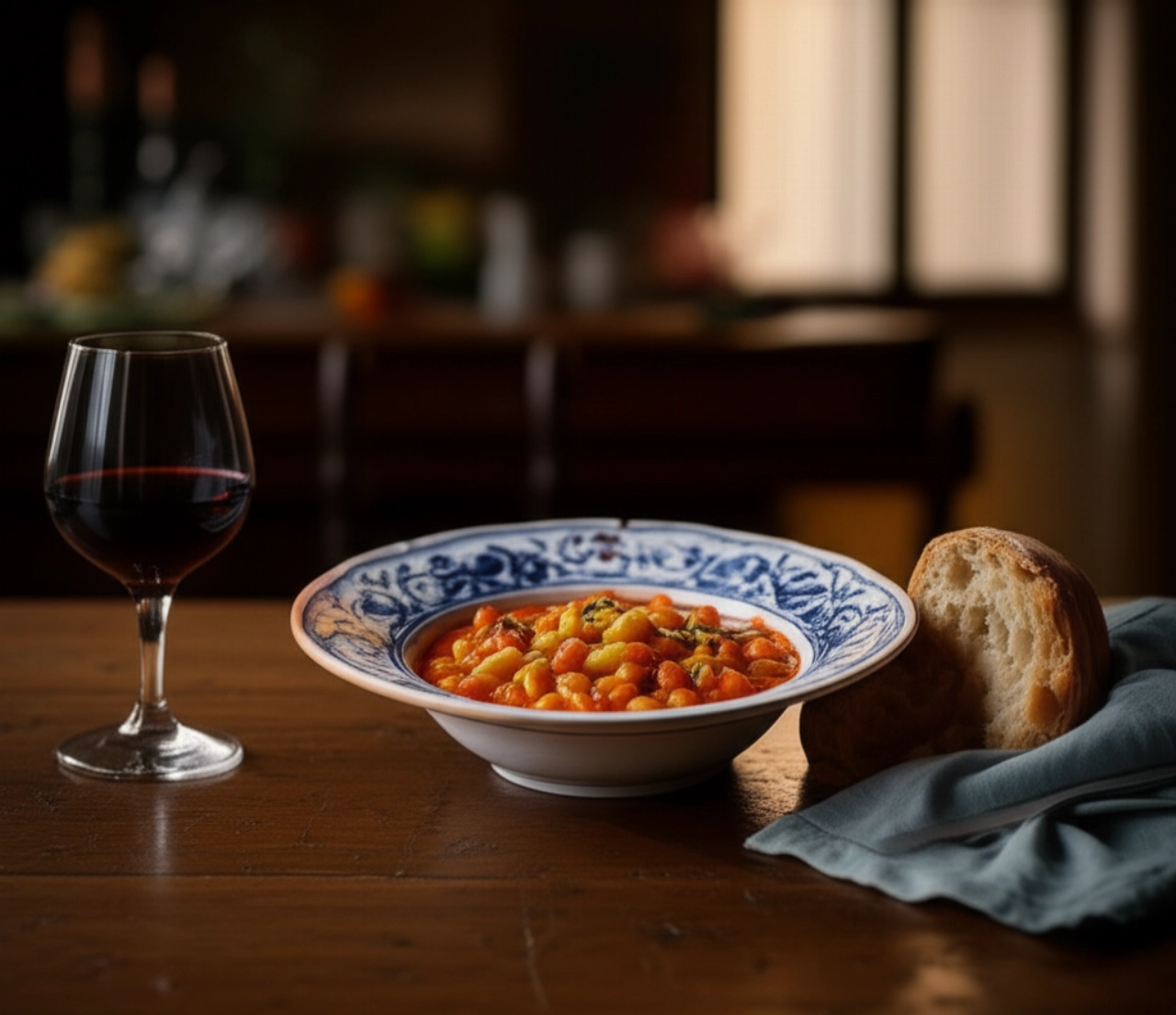
Grandma's Secret: That Magical Touch That Makes Pasta e Fagioli Unforgettable
My grandmother, the Queen of the kitchen, had a little secret for her Pasta e Fagioli, a trick that made it truly inimitable. It wasn't written in any recipe book, but passed down from generation to generation. She always used to say: "A good dish comes from a good base and patient waiting."
Her secret was to add, along with the soffritto and lardo, a small piece of pork rind or, if she didn't have it, a well-aged Parmigiano Reggiano rind. These elements, cooked slowly, release an incredible umami flavor and some natural gelatin that contributes to that enveloping creaminess we love so much. The pork rind was then removed before serving, while the Parmigiano rind softened and could be enjoyed. It's a small gesture, but believe me, it makes a huge difference in the final flavor, giving that depth and that "grandma's dish" feeling we seek.
Let's Prepare Pasta e Fagioli Together: The Step-by-Step Guide to a Masterpiece
Ingredients (for 4 servings):
- 250 g dried borlotti beans (or 500 g fresh/canned borlotti beans)
- 150 g mixed short pasta or ditalini rigati
- 50 g lardo or unsmoked pancetta (optional)
- 1 medium carrot
- 1 celery stalk
- 1/2 yellow onion
- 1 clove garlic
- 1 sprig fresh rosemary
- 200 ml tomato passata
- About 1 liter hot vegetable broth (or bean cooking water)
- Extra virgin olive oil
- Salt and freshly ground black pepper to taste
- Parmigiano Reggiano rind (optional, for grandma's touch)
Equipment:
- Large pot with a thick bottom
- Sharp knife and cutting board
- Ladle
- Potato masher or fork
Instructions:
- Prepare the Beans (if dried): If using dried beans, soak them in plenty of cold water for at least 12 hours (preferably 24), changing the water a couple of times. After soaking, drain and rinse them. Place them in a pot with cold water that generously covers them, bring to a boil, and cook over low heat for about 1 and a half – 2 hours, or until tender. Do not salt the cooking water! If using fresh beans, boil them for about 40-50 minutes. If using canned ones, rinse them well under running water.
- Prepare the Soffritto: Meanwhile, finely chop the carrot, celery, and onion. Also chop the lardo or pancetta (if using).
- Start the Base: In a large pot with a thick bottom, add a drizzle of extra virgin olive oil. Add the chopped lardo/pancetta and let it melt gently over very low heat. Once the fat has melted, add the chopped carrot, celery, and onion, the whole garlic clove (which you will remove later), and the sprig of rosemary. Let it sauté slowly for at least 10-15 minutes, stirring often, until the vegetables are very soft and transparent. This is the heart of the flavor.
- Add Tomato and Beans: Add the tomato passata to the soffritto and let it cook for 5 minutes, stirring. At this point, add the beans (already cooked and drained, but save their cooking water if you used it).
- Create Creaminess: Take about a third of the beans from the pot and coarsely mash them with a fork or a potato masher directly in the dish. Return the mashed beans to the pot. This step is crucial for density! If using Parmigiano rind, add it now.
- Cook the Pasta: Add the hot vegetable broth (or bean cooking water) until it generously covers the beans. Bring to a boil, then add the pasta. Stir well and cook the pasta directly in the bean broth, following the times indicated on the package, but tasting often. If necessary, add more hot broth, little by little, to maintain the right consistency. The pasta will release its starch, helping to thicken everything.
- Finish and Serve: When the pasta is al dente, turn off the heat. Remove the garlic and rosemary. Season with salt and pepper. Let the Pasta e Fagioli rest for 5 minutes off the heat, covered, so that the flavors meld and the creaminess stabilizes. Serve with a drizzle of extra virgin olive oil and, if you like, a sprinkle of grated Parmigiano.
Tips and Frequently Asked Questions about Pasta e Fagioli
Here are some of the questions I'm asked most often, with my answers from a "kitchen guardian":
Can I use canned beans?
Yes, you can, but with some precautions. Choose good quality borlotti beans, rinse them very well under cold running water to remove the preserving liquid and metallic taste. Keep in mind that the flavor will be less intense compared to dried beans cooked from scratch, which release more starch and flavor into the broth. In this case, use a good vegetable broth to compensate.
Which pasta is best for Pasta e Fagioli?
Tradition calls for mixed short pasta, often called "pasta mista" or "pastina mista," which is a mix of different shapes. Alternatively, ditalini rigati, tubetti, or even maltagliati are excellent. The important thing is that they are shapes that "capture" the sauce well and don't break down too much during cooking.
What if my Pasta e Fagioli turns out too watery?
If your Pasta e Fagioli is too watery at the end of cooking, don't despair! The trick is to take another ladleful of beans (and a little broth), mash them very well, and return them to the pot. Let it simmer over low heat for a few minutes, stirring, until it thickens. The starch from the beans will do its job. Avoid adding flour or starches, as they would alter the authentic flavor.
Can I prepare Pasta e Fagioli in advance?
Absolutely yes, in fact, it's often even better the next day! Pasta e Fagioli is one of those dishes that gains flavor by "resting." If you prepare it in advance, keep in mind that the pasta will absorb a lot of liquid. When reheating, add a little hot vegetable broth to bring it back to the right consistency and stir well.
Can Pasta e Fagioli be frozen?
Yes, it can be frozen, but with a small caveat. If you freeze it with the pasta already in it, the pasta might become a bit soft and break down once thawed. My advice is to freeze only the bean and broth base, without the pasta. When you want to enjoy it, thaw the base, bring it to a boil, and cook fresh pasta directly at that time. This way, you'll always have perfect Pasta e Fagioli!
A Flavorful Embrace: Your Applause-Worthy Pasta e Fagioli
There you have it! Now you no longer just have a recipe, but all the secrets to bring to the table a Pasta e Fagioli that is not just a dish, but a warm embrace, a renewed memory, a taste that speaks of home, tradition, and love. It's the certainty of success that will make you feel like a true chef, even if you're just starting out.
Don't be afraid to put yourself to the test. Every time will be a success, I guarantee it. Cooking is an act of creativity and generosity, and with this solid foundation, applause will not be lacking.
Have you tried our recipe? We're very curious to know how it went! Leave a comment below, tell us about your experience, or share a photo on Instagram by tagging @CercaRicette.it. If you loved this Pasta e Fagioli, also discover our recipe for Grandma's Vegetable Minestrone, another heart-warming classic, or for a main course that will make you want to "scarpetta" (mop up the sauce with bread) like the Perfect Stewed Lentils. Until next time, and bon appétit!
